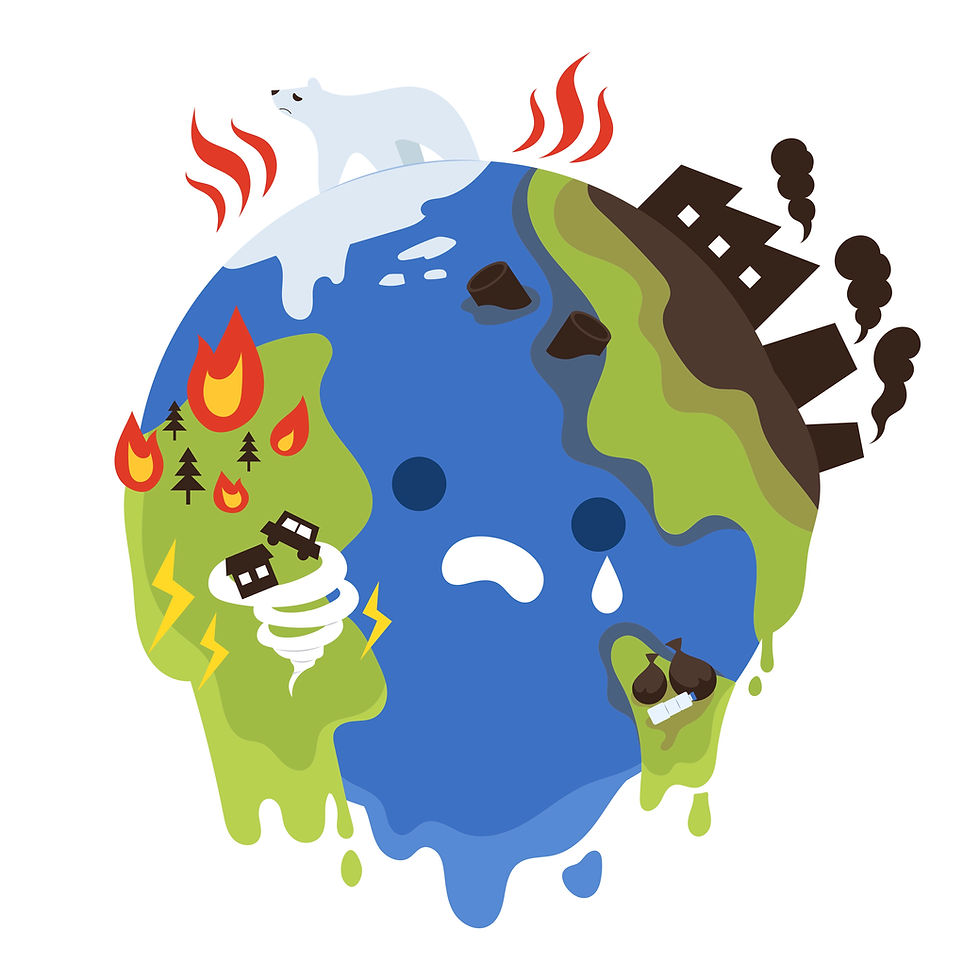Climate Change's Broad Impact on Infectious Diseases
- P.K. Peterson

- Oct 12, 2022
- 3 min read
“Climate hazards are expected to aggravate 58% of all known human pathogens. That’s over half of infectious diseases discovered since the end of the Roman Empire.”
- Camilo Mora, Associate Professor University of Hawaii, Department of Geography and Environment
“You can’t have a healthy life on a sick planet.”
- John Replogle, President and CEO, Seventh Generation
Many health organizations heralded the U.S. Congress’s passage of the Inflation Reduction Act in August as a watershed moment across a host of critical health-related issues, not the least of which is climate change. Recent studies indicate that climate change plays a much larger role in fostering infectious diseases than previously thought. In this Germ Gems post, I provide an update on how infectious diseases could be impacted by this ambitious legislation.

Climate change: a human health emergency. In addition to fighting inflation, the benefits of the Inflation Reduction Act of 2022 include reducing health care costs, lowering prices of prescription drugs, creating jobs, and most notably, making historic investments ($369 billion worth) to tackle climate change by spending on clean energy and cutting carbon pollution.
The generation of greenhouse gases (GHGs), mainly carbon dioxide and methane, is the major driver of climate change, and human behavior is a major contributor to GHGs. Climate change now needs to be considered a human health emergency. (See the January 2021 article, “The 2020 report of the Lancet Countdown on health and climate change: responding to converging crises,” and the January 2022, Nature Medicine article, “Putting health at the center of climate action.”)
In the field of health care, the toll of climate change can be seen in virtually all disciplines of medicine, including cardiovascular, pulmonary, neurological, and gastrointestinal disorders, as well as in many aspects of social medicine. For example, in a study published in 2016 in EBioMedicine, Aditi Bunker and his colleagues reported that for the elderly (age 65 and above) a 1 degree C temperature rise increased cardiovascular mortality by 3.44%, respiratory mortality by 3.60% and cerebrovascular mortality by 1.40%. Moreover, with the almost weekly evidence of climate change-related health emergencies due to extreme heat, flooding, hurricanes, and the like, climate change is now “in our face.”
Climate change and infectious diseases. The thinking about how climate change impacts infectious diseases has evolved. Initially, the focus was on environmental change (warming) leading to expanded geographical range and breeding season of certain vectors for disease, such as mosquitoes (e.g., vectors for malaria) and ticks (e.g., vectors for Lyme disease). In addition, researchers recognized the impact of global warming on water-borne pathogens. For example, the bacteria that cause cholera (Vibrio cholerae) and blue-green algae (cyanobacteria) thrive in warmer waters.
It now appears that the impact of climate change on infectious diseases is much broader than originally thought. In the article “Over half of known human pathogenic diseases can be aggravated by climate change” published in Nature Climate Change on August 8, 2022, the authors posit that 58% of all 375 known human infectious diseases are made worse by one of 10 types of extreme weather connected to climate change.

In this new study, the researchers combed through the medical literature of established cases of illnesses caused by microbes (viruses, bacteria, fungi, and parasites) and mapped 1,006 pathways from climate hazards to people sickened by the pathogens. They found that not only are many climatic hazards bringing pathogens closer to people but climatic hazards are bringing people closer to pathogens. They found that “climate hazards such as flooding, heat waves and drought have worsened more than half of the hundreds of know infectious diseases in people, including malaria, hantavirus , cholera and anthrax.” They concluded: “The sheer number of pathogenic diseases and transmission pathways aggravated by climatic hazards reveals the magnitude of the human health threat posed by climate change and the urgent need for aggressive actions to mitigate GHG emissions.”
Investment in the health of Patient Earth. Dr. David Patz, director of the Global Health Institute at the University of Wisconsin, and a co-author of the study published in Nature Climate Change referenced above, stated, “If the climate is changing, the risk of these [infectious] diseases are changing” and we need “to think of the diseases as symptoms of a sick Earth.” Finding new ways of addressing climate change may provide treatment for “patient Earth.”
From an ecosystem perspective, the wellbeing of animals (including Homo sapiens), plants, and even microbes, is connected to the inanimate components of our environment, including air, water, and mineral soil. This means that the approach to addressing climate change must be interdisciplinary. Therefore, it is no surprise that studies of climate change at many universities, including the University of Minnesota where I worked, are evolving into “Planetary Health” with an interdisciplinary emphasis on “Patient Earth.” The Inflation Reduction Act should provide funding to help energize these projects.




Comments